Posted by June Underwood on January 4th, 2008
Here at the Montana Artists Refuge, I find myself limited to the materials and ideas at hand. In Portland, I have access to two physical locations of Powell’s books as well as various used book stores and the big national chains. I also am within easy travel distance of four large art supply stores. Delivery of online orders is fast and easy. In Basin Montana, none of the above are present. So I have to make do with what I have available to me. And what I have available is sometimes just eccentric enough to be more than merely useful.
Along with my Phaidon biography of Cezanne (by Mary Tompkins Lewis) and a Dover book of Durer’s Drawings, I brought a copy of Gregg Kreutz‘s Problem Solving for Oil Painters. The book resides in my studio where I thumb through it when I need to rest my fingers and arm and eye from the physical act of painting.
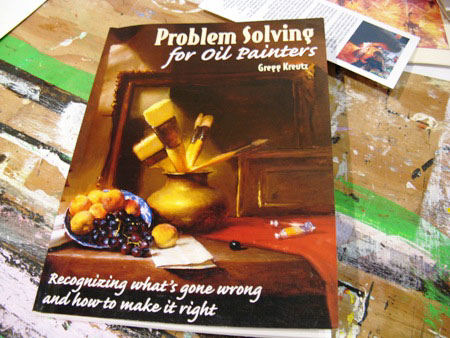
I’m not recommending (and yet not not recommending) the book exactly; Kreutz is a bit too dogmatic for my tastes. Yet he does give me some things to push off from. more… »
Posted by June Underwood on September 14th, 2007
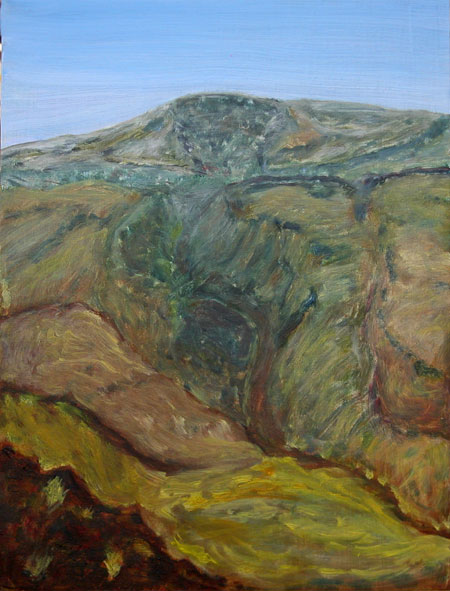
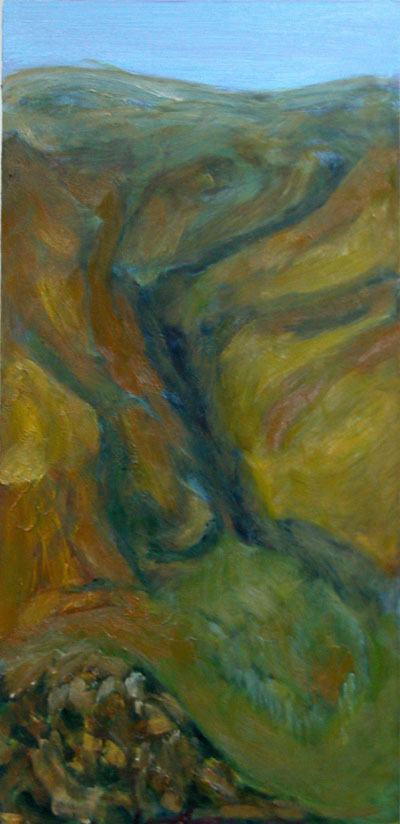
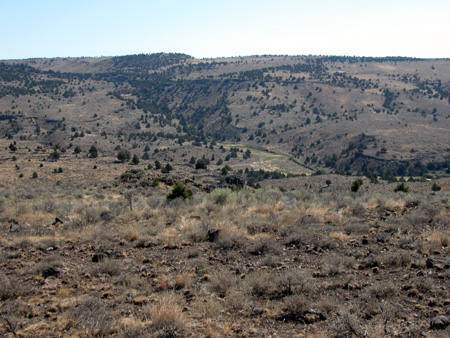
Underwood, Stinking Water Area, large and small oil on masonite, and a photograph, off the Stinking Water Acess Road.
“I took my easel and canvas and brushes to the top of the bluff, and painted two views from the same spot…. From this enchanting spot there was nothing to arrest the eye from ranging over [the Missouri’s] waters for the distance of twenty or thirty miles.”
[Artist George Catlin, as quoted in William H. Truettner, The Natural Man Observed: A Study of Catlin’s Indian Gallery (Washington, D.C.: Smithsonian Institution Press, 1979), p. 247, found on the of the Smithsonian website.
As Karl said (here) one has to become acquainted with the landscape before one can paint it. And as George Catlin remarked about a different landscape “there was nothing to arrest the eye…for the distance of twenty or thirty miles.
Aside from artistic masochism, why do we paint landscapes?
more… »
Posted by Sunil Gangadharan on September 13th, 2007
Recently, I embarked on a little mini project in a bid to better understand the vagaries of photography. I find photography a hard master and am still unable to photograph my paintings to the level of detail I want… This mini-project may just be regarded as another attempt at understating photography better. The premise was simple: Instead of turning the camera to outside subjects like “people, landscape, houses, family’, I decided to turn it inwards. I decided that I was going to photograph just objects in and around the confines of our home. What initially was envisaged as a dull chronicle of household items turned out to be quite an exciting one (at least for me).
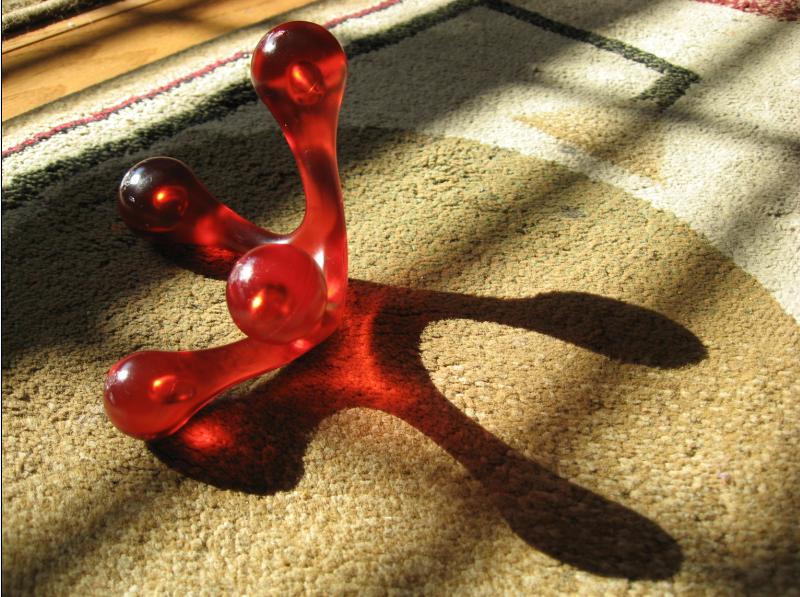
Sunil Gangadharan, ‘Juxtaposition’, digital photograph
I took about 50 pictures in a space of about two hours. All of them shot inside. I have posted a majority of them to the flickr site here. To see as slideshow click here.
So, instead of asking some serious art question (which I frequently find myself thinking more and more), I decided to take it easy and play.
Posted by Steve Durbin on August 4th, 2007
Certain artists are unable to develop because they are disconnected from history. To me development is paramount. I think that development and humility go hand in hand.
-Sean Scully
Do we expect, rather, that successful development demands arrogant self-certainty? On reflection perhaps not, for arrogance implies that an artist knows dogmatically how to proceed, while humility involves productive acknowledgment of deep uncertainty.
-David Carrier, in Sean Scully
Posted by Doug Plummer on June 5th, 2007

Two recent blog entries, one by Paul Butzi (I’ve been riffing off him a lot lately) on photographing “Close To Home,” and Birgit’s “Dune Quest” have got me thinking about the notational aspects of artmaking. Namely, the daily investigation of ideas and how that relates to projects of “greater” importance.
more… »
Posted by Doug Plummer on May 21st, 2007
Paul Butzi has a provocative series of posts on Musings, in his typically thoughtful style, about the necessity to seal himself off from influences, particularly the media. I have great respect for his thinking, but I offered a different take in a long comment on his recent post. I’m appropriating myself and posting it here.
Paul,
As I understand you position, you’re saying that in order to protect the integrity of your experience, you have to deliberately isolate yourself from stimulus that might become a mediating influence, because it deters and inhibits the sense of being in the moment.
My retort is twofold, one about artistic influences, and the other about mass media (we won’t talk about the intersection of these two sets, which is an interesting arena that a lot of artists use to make some important work, and always have). I contend that isolating yourself from other artistic influences is a big disservice to one’s own process.
My feeling is, that the more I know about what has gone on before me, the more roots there are to feed my own work. I visit museums and galleries whenever I travel, and I make it a priority. I have arenas of art work that I like to look at and that I respect, and large swaths that I pretty much ignore. But I don’t prohibit it from feeding my process. Even work I argue with grows me.
Allowing Italian Renaissance art into one’s process is one thing. Mass media is harder to defend. But much of the art I adore was the mass media of its era. I am writing this while I am watching my guilty pleasure, “Dancing With The Stars.” I’m working on a dance project. I’m interested in the popular culture take on dance, and I love that this show highlights and rewards a kind of (well, vulgur) virtuosity. Because I make a living from my artistic process, I pay attention to the trends and patterns in how the media mediates our culture back to ourselves.
I don’t like a lot of what I see, of course. That’s beside the point. Anyone with a lick of self respect is going to be majorly frustrated with the culture we live in. The way I inoculate myself from the media onslaught is to pay attention to it. I deconstruct how it works, what it’s trying to say, and the meta messages within it. But sometimes the production values speak to some of the best artistic output of our era. Or at least, it informs me about what is the visual vocabulary of our time.
Posted by Steve Durbin on March 30th, 2007
Over the last few months, several posters have mentioned books that have been important to them. Karl considers Cennino Cennini to have written the best how-to book for painters. Doug gave us a report on a concise and readable book about photography by Steve Edwards. Lisa Hunter talked about her own book, “The Intrepid Art Collector,” in an interview. Rex cited in one post a motivational book for painters (the correct title is “How to Make a Living as a Painter,” by Kenneth Harris). David, in a comment, recommended “Seeing Is Forgetting the Name of the Thing One Sees: A Life of Contemporary Artist Robert Irwin.”
What is your favorite art book?
 One of my mine, I just discovered, has popped up in comments a couple of times: Art and Fear, by David Bayles and Ted Orland (that’s Orland’s “One and a Half Domes, Yosemite” at left). As it happens, they are both photographers, but the book is not at all confined to photography or even visual art. As you might guess from the title, it’s a frank discussion of issues that are faced by artists that relate to making public creative work that can be very personal. Even if you’ve never been the slightest bit nervous about putting your work out there, I still think the book is helpful as an unusually readable treatment of what artists do and how they do it. It will help you think about your own process. Just read it.
One of my mine, I just discovered, has popped up in comments a couple of times: Art and Fear, by David Bayles and Ted Orland (that’s Orland’s “One and a Half Domes, Yosemite” at left). As it happens, they are both photographers, but the book is not at all confined to photography or even visual art. As you might guess from the title, it’s a frank discussion of issues that are faced by artists that relate to making public creative work that can be very personal. Even if you’ve never been the slightest bit nervous about putting your work out there, I still think the book is helpful as an unusually readable treatment of what artists do and how they do it. It will help you think about your own process. Just read it.
Over to you: help me add to the list!





 One of my mine, I just discovered, has popped up in comments a couple of times:
One of my mine, I just discovered, has popped up in comments a couple of times: